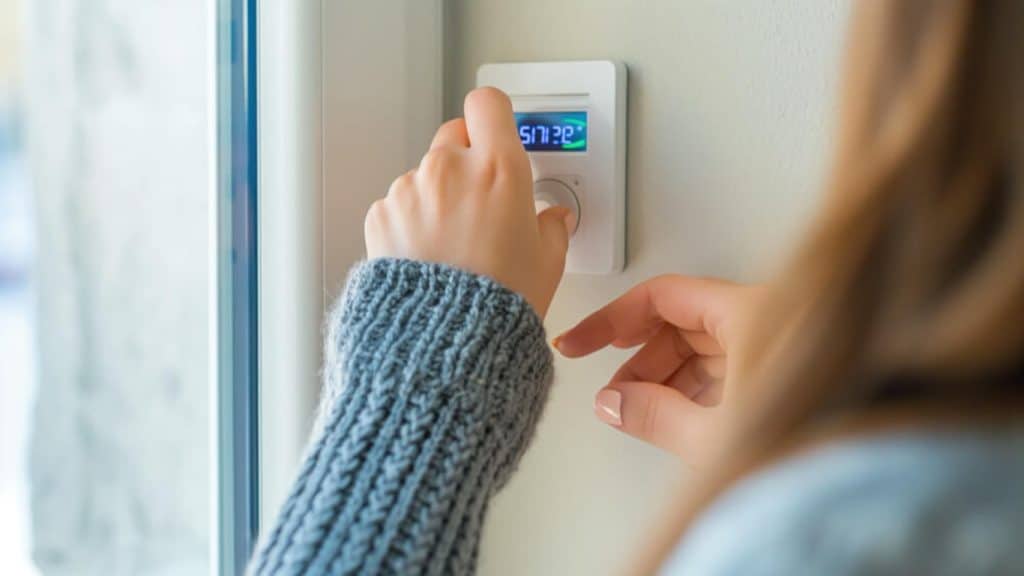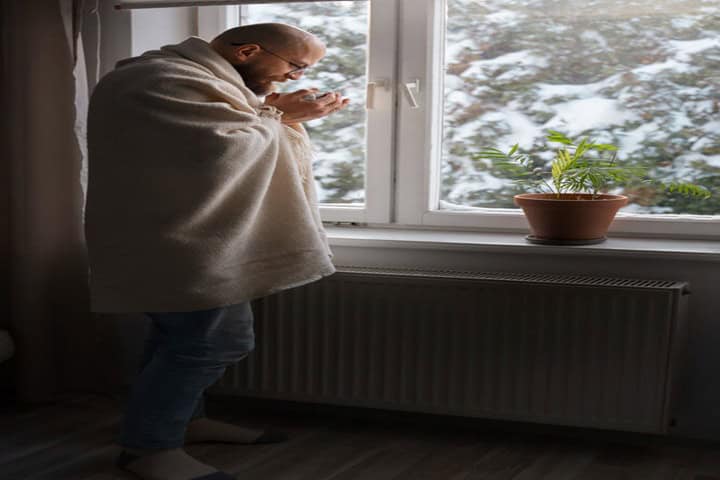
Struggling to find the perfect nighttime temperature for your central heating thermostat? Find out how adjusting your thermostat settings can save energy and improve comfort in your home.
Getting your thermostat settings right at night can make a huge difference in both energy bills and sleep quality. In this article, we’ll explore the best temperature settings for different rooms, the importance of maintaining a steady temperature, and how modern heating systems like Smart thermostats can help you achieve the perfect balance between comfort and efficiency.
Key Points:
- Ideal thermostat settings for bedrooms, living rooms, and other spaces.
- The benefits of using a Smart thermostat.
- How keeping the heating on can reduce damp and mould.
- Tips to ensure energy efficiency and comfort all year round.
5 Mistakes People Make With Their Thermostat
Controlling your central heating system with a thermostat is an efficient way to manage energy use and stay comfortable. However, many people unknowingly make mistakes that lead to higher energy bills and discomfort.
Mistake 1: Setting the Wrong Temperature at Night
A common question many ask is, what temperature should a central heating thermostat be set at night? The answer isn’t one-size-fits-all. Many people tend to overheat their homes, especially at night, which can lead to restless sleep and higher heating costs.
Mistake 2: Constantly Switching the Heating On and Off
Many homeowners think turning the heating off when leaving the house will save energy. However, this can lead to higher costs in the long run. Instead of constantly switching the heating on and off, consider setting a setback temperature. But what is a setback temperature?
A setback temperature keeps your home at a lower temperature when you’re away, preventing it from cooling down too much. This is particularly important during colder months, as it stops heat loss and keeps the house at a manageable baseline temperature. A good starting point for a setback temperature is 16°C. This prevents your heating system from working too hard when you return and want to warm up the house quickly.
Using Smart thermostats can make this even easier, as they automatically adjust the temperature based on whether you’re home or away, ensuring maximum efficiency.
Mistake 3: Turning Up the Thermostat to Heat the House Faster
When you come home to a cold house, the temptation is to crank up the thermostat in the hope of warming things up faster. But here’s the truth: this doesn’t work. Your heating system heats at the same speed, regardless of the temperature you set. So, what temperature should heating be set at?
It’s best to keep your thermostat set to a steady temperature for comfort in living spaces. Rather than overloading your system, keep your thermostat consistent, and allow it to reach the optimal temperature without overcompensating.
Mistake 4: Using a Manual Thermostat Instead of a Smart Thermostat
Traditional thermostats require manual adjustments, which can be inconvenient and inefficient. A Smart thermostat, on the other hand, learns your heating preferences and adjusts accordingly.
Smart thermostats can be programmed to lower the temperature when you’re not home, raising it just before you return, ensuring comfort without waste. This adaptability is crucial if you’re looking for the recommended thermostat settings in the UK to ensure your heating system works at peak efficiency all year round.
Mistake 5: Installing the Thermostat in the Wrong Place
The location of your thermostat plays a role in how well it functions. If you place your thermostat in a spot that is too cold (like near windows or drafts) or too warm (near heat sources like ovens or direct sunlight), it won’t accurately reflect the temperature of your living spaces.
To avoid this, install your thermostat on an interior wall at about eye level, away from direct heat or cold sources. This ensures that it gets the most accurate reading possible, allowing your heating system to function effectively.
If you’re not sure how to take a meter reading? Follow our easy step-by-step guide: How to Take a Meter Reading.

Best Thermostat Temperature for Winter
Winter brings colder weather, and adjusting your thermostat to the right temperature can help you stay comfortable while keeping heating costs under control. Here are some extra winter energy savings tips to keep your home warm while reducing your heating costs during the colder months. So, what temperature should the central heating thermostat be set at night? The recommended thermostat settings in the UK suggest keeping your thermostat between 18°C and 21°C during the winter months.
Different rooms may need different temperatures to maintain comfort:
- Living Room: Aim for 18°C to 21°C, as this is the space where you’re likely to spend most of your time sitting and relaxing. Since you’re not moving around much, you may feel colder and need the room to be slightly warmer.
- Bathroom: The bathroom is typically the warmest room in the house. Setting the thermostat to 20°C can provide a comfortable environment, and with the heat from the shower or bath, the temperature can naturally rise to around 22°C.
- Bedroom: Most people prefer a cooler bedroom for sleeping. Setting the thermostat to around 18°C is ideal for a restful night’s sleep, as this prevents overheating under the covers.
- Kitchen: Since the kitchen generates heat while you cook, it doesn’t need to be as warm as other rooms. Keeping the thermostat set between 16°C and 18°C is usually enough to stay comfortable without the space feeling too hot.
Keep the Heating On for Optimal Comfort
Turning off the heating when you’re not at home may seem like a good way to save energy, but this can make it difficult to maintain a comfortable temperature. A sudden drop in temperature can lead to condensation, dampness, and even mould, which can damage your home and affect your health. Instead, keep the heating on a low setting, such as 18°C, and use a Smart thermostat to lower it when you’re away.
Keeping the heating on overnight at a steady temperature also ensures that everyone in the household remains comfortable and the heating system doesn’t have to work too hard to warm up the house again.
Close Doors to Retain Heat
One simple but effective way to maintain the temperature in your home is by keeping doors closed. When doors are left open, cold air from unheated rooms can flow into the spaces you’re trying to keep warm, forcing your heating system to work harder. By closing the doors, you can keep the warmth in the rooms you are using and prevent energy waste. This simple practice complements other heating strategies and makes it easier to maintain an even temperature throughout your home, especially during the colder months.
Add Thermostatic Radiator Valves for More Control
For more precise control over the temperature in individual rooms, consider installing thermostatic radiator valves (TRVs). Unlike manual radiator valves, which simply turn the radiator on or off, TRVs allow you to adjust the heat output on a numbered scale, offering much finer control. This means that instead of guessing what setting will make your room comfortable, you can adjust the radiator to your preferred level, such as setting it to number 4, which you know works well for your living room.
Another benefit of thermostatic radiator valves is that they allow you to stop heating rooms that aren’t in use. This is especially helpful for cutting down on energy use in spaces like guest rooms or storage areas. TRVs can turn radiators off completely, allowing you to save on heating costs while still maintaining comfort in the rooms you are using. Furthermore, underfloor heating can increase your property value as well as heating efficiency, learn more by reading our blog: Does Underfloor Heating Add Value?
What About Electric Radiators?
Electric radiators offer a flexible solution for heating individual rooms without having to turn on your entire central heating system. This is particularly beneficial if different people in your home have different temperature preferences. So, what temperature should the central heating thermostat be set at night if you’re using electric radiators? Generally, the same range of 18°C to 20°C applies, as this is considered the most comfortable setting for most rooms.
The advantage of electric radiators is that they allow for more targeted heating. If someone doesn’t want the heating on in one part of the house, they can simply switch on their electric radiator without affecting the rest of the property.
Many electric radiators now come with Smart heating elements that allow you to program specific settings, such as memory mode and timers, so that you can control when and how the radiator heats a room. You can even connect them to Wi-Fi, which gives you the ability to manage your heating from your phone. If you’re looking to upgrade your heating system, read our guide on Central Heating Systems to discover the best solutions for your home.

What’s the Ideal Temperature for a Baby’s Room?
When it comes to newborns, maintaining the correct room temperature is essential. According to the Lullaby Trust, the ideal temperature for a baby’s room should be between 16°C and 20°C. This helps reduce the risk of Sudden Infant Death Syndrome (SIDS), which can be heightened if the room is too hot. So, what temperature should I set my thermostat at if you have a baby? Keeping the temperature between 16°C and 20°C ensures a safe and comfortable environment for your child.
What Temperature Is Ideal for Older People?
Temperature is critical for the health and comfort of elderly family members. According to Age UK, vulnerable people, particularly older adults, should keep their living areas at around 18°C to avoid health risks. A room temperature below 9°C can lead to hypothermia, while temperatures between 9°C and 12°C, or above 24°C, increase the risk of heart attacks and strokes. Therefore, the recommended thermostat settings in the UK for older individuals aim to maintain a steady and comfortable 18°C in living spaces like the bedroom and living room, with radiators in unused rooms turned down to conserve energy.
Should You Heat Your Home When on Holiday?
Heating your home during a holiday can be tricky. If there’s a chance of freezing temperatures, leaving the heating on at a low setting can prevent your pipes from freezing and causing costly damage. Many modern thermostats, like the Hive Thermostat, come with a frost protection mode that automatically turns the heating on if the temperature drops below 7°C. For those without this feature, setting your thermostat to at least 5°C can provide similar protection.
In the summer, however, it’s safe to turn off your heating while you’re away unless you have pets at home or you’re worried about mould and mildew building up.
In conclusion, setting the right temperature for your central heating is essential for maintaining comfort and efficiency. Aim for a steady 18°C to 20°C in most rooms, and consider using Smart thermostats or electric radiators for better control. Whether you’re managing heating for babies, elderly individuals, or general household comfort, small adjustments can make a big difference in energy savings. Keep doors closed, use thermostatic valves, and ensure proper thermostat placement to optimise your home’s heating system.
Need advice on heating systems or product recommendations? Reach out via our Contact Us page for expert assistance. Our Underfloor Heating solutions will swiftly upgrade your home’s comfort and energy efficiency.
FAQs
Is 16 degrees cold for a house?
Yes, 16°C can feel cold for many people, especially during extended periods. While 18°C is recommended for bedrooms at night, temperatures below 16°C may diminish resistance to respiratory diseases and increase discomfort.
Is it efficient to turn the thermostat down at night?
Yes, lowering the thermostat at night is efficient. You can save up to 15% on heating bills by reducing the temperature by around 4°C for eight hours overnight.
Is it safe to use space heaters at night?
Yes, space heaters can be safe if they have features like automatic shut-off for overheating or tipping. However, they should be placed at least three feet away from anything flammable and never left unattended.
How much can I lower my thermostat at night without feeling too cold in the morning?
Lowering the thermostat by 2-5°C from your daytime setting is a good rule of thumb. For example, if your daytime setting is 21°C, set it to 15°C-18°C at night for comfort and savings.
Sources
Lullaby Trust (2013) Homepage [online] Available at: https://www.lullabytrust.org.uk/ [accessed 07/10/2024]
Age UK (2009) Homepage [online] Available at: https://www.ageuk.org.uk/ [accessed 07/10/2024]
